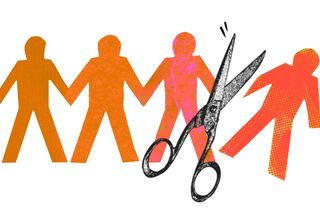
Research Shows Social Exclusion Is a More Common Form of Bullying Than Physical, Verbal Attacks
“When a kid is excluded from social activities… the outcomes… [are] as detrimental as if they got kicked, punched or slapped every day.”

Bullying is a form of abuse that is often employed to harm or intimidate people. But when we hear of someone being bullied, the images that often come to mind are those of physical aggression or verbal attacks. But deliberately isolating people — either by excluding them from group activities or shunning them completely — is also a form of bullying too, albeit a covert one. That’s precisely why social exclusion is sometimes described as “bullying, incognito.” And, according to a new study, it’s actually a more common form of bullying, too.
Published in Preventing School Failure: Alternative Education for Children and Youth, the study was based on an assessment of more than 14,000 students enrolled in middle and high schools across parts of the U.S. Also called “relational aggression” — since it harms one’s social status, impacting their social relationships — social exclusion was found to be the most common form of bullying.
The study may have only included school students, but that doesn’t mean social exclusion as a bullying tactic, isn’t perpetrated upon — and practiced by — adults.
“Bullies often create an inner circle of compliant colleagues who will not threaten their reign, while purposefully excluding talented and curious employees who could question them… Exclusion is effective in reaching this goal, for humans’ innate need to belong makes some willing to abandon their values and beliefs in order to gain access to the inner circle,” Dorothy Suskind, an assistant professor at Longwood University in Virginia, wrote in Psychology Today.
Social exclusion is enacted through a multitude of strategies. One is by poisoning people’s minds against someone — either by using one’s social capital to force people to carry out their bidding, by disclosing any sensitive, marginalizing information they may have about their target of bullying, or simply, by spreading lies about the target. This is all done in a bid to ensure their exclusion. Another tactic a bully might use is to shame their target in public for trying to approach and interact with others, thereby preventing them from being integrated into groups. The more obvious and common tactic, though, is purposefully leaving people out with the deliberate intention of hurting them through exclusion.
Related on The Swaddle:
Many Indian Families Express Care Through ‘Bullying,’ Creating Patterns of Abuse
The fact that social exclusion appears to be an act of omission than one of commission creates the impression that it’s less damaging. But just because it seems more subtle and indirect compared to tangible, physical aggression, doesn’t actually make it less harmful.
“When a kid is excluded from social activities by their peers at school, the outcomes for that kid both short-term and long-term will be just as detrimental as if they got kicked, punched, or slapped every day,” noted co-author Chad Rose, who is the director of the University of Missouri Bullying Prevention Lab.
As Suskind had noted, “Exclusion is one of those fly-under-the-radar strategies in the bully’s playbook that results in the victim’s thwarted sense of belonging and intense and prolonged psychological suffering… [T]he exclusion is purposeful, calculated, and repeated, resulting in the victim’s body registering the hurt similarly to physical pain.” But since the pain inflicted, here, is less visible than the wounds resulting from physical aggression, people tend to downplay the torment that their classmates and colleagues experience.
The perception of social exclusion not being nearly as harmful as visible forms of aggression also enables its perpetuation — allowing it to continue unaddressed through any form of intervention. “We teach the famous tagline, ‘See something, say something,’ but in practice, it is hard for kids to intervene and assess conflicts quickly — it’s hard even for adults. If we see two kids in a physical fight, we feel an obligation to break it up. But when we see kids being excluded by their peers, adults don’t always seem to view it as equally damaging, and that’s the scary part,” Rose explained.
By virtue of not even recognizing — and, by extension, acknowledging — social exclusion as bullying, bystanders can end up reinforcing it, irrespective of their intentions, Rose adds. This happens because, in the absence of any opposition, social exclusion can seem like a “group attack,” when in reality, it’s often “the product of a single person’s determination in making you feel bad,” as an article on Psych Central suggests.
Related on The Swaddle:
The Stereotype That Abusers Are ‘Bad’ People Can Prevent Survivors From Recognizing Real‑Life Abuse
However, learning about social exclusion as a form of bullying might lead one to wonder whether they would be deemed a “bully” for simply not wanting to hang out with a specific person they dislike. The answer to that is: no; simply avoiding a person doesn’t make one a bully — unless there’s an intent to hurt them through deliberate exclusion.
“It’s very natural to simply not get on with someone and you may not necessarily want them in your group chat or online gaming crew… It’s not bullying behavior if you simply don’t gel with someone and you don’t particularly want to interact with them — but it’s important that you still act in a civil and polite manner,” explains a primer by the Anti-Bullying initiative of the Diana Award. “The general rule is that if you are purposefully excluding someone because you know it will upset them — that is bullying behavior.” The intent, here, adds the element of hostility that transforms mere avoidance into exclusion, and by extension, into abusive behavior.
Given that relational aggression isn’t just restricted to schools and makes its way into adult dynamics, too, acknowledging the damage it can do, and trying to be alert of it being done to people around us, might help in a number of ways. As Rose noted, “Bullying does not begin or end with the school bells; it is a community issue.”
Greater awareness can, perhaps, deter bullies from engaging in the tactics — understanding the behavior is wrong could, potentially, make it more unacceptable socially. In doing so, perhaps, it can stop people from perpetuating — or worse, normalizing — social exclusion, gradually curbing its prevalence.
Recognition of social exclusion as a form of bullying might also allow the ones being excluded to feel that their pain is valid — as one hopes the present study has done.
Devrupa Rakshit is an Associate Editor at The Swaddle. She is a lawyer by education, a poet by accident, a painter by shaukh, and autistic by birth. You can find her on Instagram @devruparakshit.
Related


Large‑scale Study Indicates Vitamin D May Ease Depressive Symptoms
